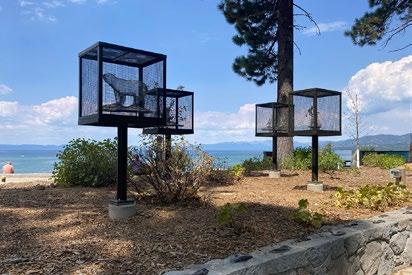




This month, we ride the new shuttle to Emerald Bay and take a look at efforts to ease the overcrowding and parking at Tahoe's most popular destination.









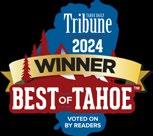









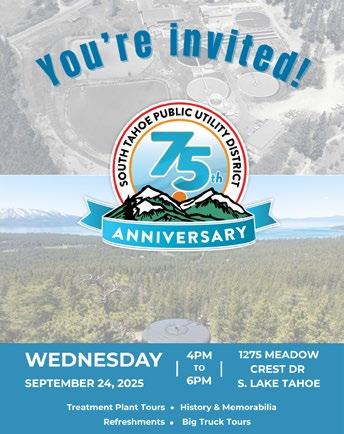





Last month, I had occasion to take an Uber here in South Lake Tahoe. The driver, Clay, and I got to chatting. He came to Tahoe 16 years ago, young and carefree like many who ended up here. Around seven years ago, he and his girlfriend decided to start saving to buy a house. Clay is currently working three jobs—freelance tree work, Uber and at a local restaurant. In the past he has worked on a forest crew for the Tahoe Conservancy. His girlfriend also works.
But real estate prices have consistently outpaced their ability to save. Recently, acknowledging the reality that they might never be able to own in Tahoe, they bought acreage in Butte County. They are rehabbing a decrepit dwelling on the property and will move there once it is habitable.
I’m not a professional economist, but free market purists would say this is how the economy works. People need to adjust the factors under their control to respond to market forces and attain their goals. Clay adjusted by seeking a more affordable real estate landscape away from Tahoe because home ownership is important to him and his girlfriend.
Clay seemed pretty happy with his decision and is
looking ahead to building the life he wants for himself, so that’s a plus. When people complain about the high cost of housing here on social media, I often see comments to the effect that no one is entitled to live here and if you can’t make it work, for whatever reason, maybe Tahoe isn’t for you. But that sort of cutthroat outlook discounts the costs, economic and otherwise, to losing two people who would have stayed here if they could. Not everything can be measured in dollars. And the South Shore labor pool will be down two people. A shrinking labor pool leads to higher prices for everyone. Sure, they might be replaced, but with new workers now entering a market where the cost of living is ever higher, paying a sustainable wage will become more expensive, again driving prices up for everyone or driving workers off the hill. The time and gas to commute to Tahoe, the increased air pollution and other factors must be considered in determining the true costs if fewer and fewer people are able to reside here and must drive in from elsewhere.
After my ride with Clay, I felt guilty that someone who is hustling harder than I am isn’t able to own a home in Tahoe. Sure, Paperboy and I worked hard over

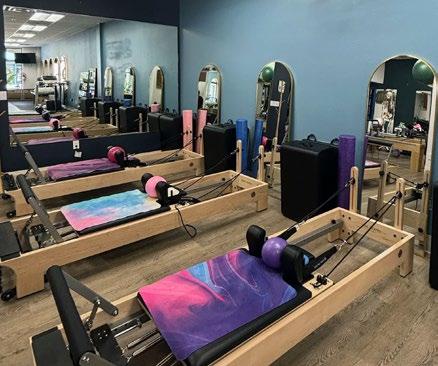


the years for what we attained, but we were also aided in some regards by luck and timing. I guess I’m not sure anyone or everyone is entitled to live here either, but finding ways to help maintain our community for the benefit of all is something we should consider. One of the last two families who live full time on my street is moving on to a larger house in town. This is the free market working positively in one sense. The house they will be vacating is a rental property and the house next door to it just went on the market for an eye-watering sum. I don’t know if the landlord will look at that and decide to sell—possibly to a second homeowner, hollowing out our neighborhood even more—or if he’ll rent it out again. This neighbor and I aren’t particularly close personally—partly because he works nights and sleeps during the day—but we know we can rely on each other when we’re in a bind and his children have become friends with my children. Maybe I’m not entitled to a good neighbor and I would definitely say their upward mobility in a tough market is to be celebrated, but I will miss them because, as the poet John Donne wrote, “no man (or woman) is an island.”
South Shore is experiencing an era of chain link chic. Not our best look but be patient—we are experiencing another period of reinvention. Properties come to the end of their economic life, are demolished and new stuff gets built or returned to nature.
A coordinated attempt to reinvent the California Stateline came with the ambitious Redevelopment Project started in the 1980s but was never fully realized, leaving a “hole in the ground” that continues to undermine the city’s economic stability. Newer pockets of reinvention exist all over the South Shore: the Tahoe Blue Event Center (approved with no additional parking and a promise of no additional vehicle miles traveled), the Whole Foods development (formerly the Super 8 Motel), Target (formerly Raley’s), Cascade Kitchens (previously Kmart’s garden center), Ulta, Sierra and Five Below have replaced Kmart, another Starbucks to replace Jack in the Box, Save Mart to replace Rite Aid and the City’s behemoth $80M (accounting verified by the city) Recreation Center. Plus, Nevada casinos are dumping millions
“How is the Stateline event center doing?”
– Curious local

into extensive remodeling projects. We are on a roll. Very recently, it has been reported that the Beach Retreat is being purchased with plans to demolish and then (just guessing) develop into a four-story luxury resort. A few years ago, this property was annexed into the Tourist Core Area, creating an opportunity for additional height and density. The buyers are billionaires, which doesn’t guarantee completion, as happened with the Tahoe Biltmore in Crystal Bay that was TRPA approved to be a Waldorf Astoria Hotel but instead fell into bankruptcy and today is a blighted mess.
Of local concern is the Beach Retreat property’s continued public access to the beach and the 18 public parking spaces. This access was legally established in 1973. The public's designated portion of this beach (June through September) includes all areas

from the high watermark to 100 feet inland plus 18 year-round parking spaces.
In 2015 the city conducted a comprehensive site evaluation and pledged to protect the public's access to this beach. The new owners may need a courtesy call.
On August 21, members of the SLT Planning Commission went off script in their attempt to overrule the laws and ordinances
After their lengthy debate/discussion, the commissioners agreed to table the item until the next planning commission meeting on September 18. Going forward, the council might consider providing the current members with professional training or find new commissioners who can avoid personal biases. Stay tuned.
As an advocate for public art and culture along with historical preservation, I hesitate to say what I was thinking when I first viewed the City’s new $100,000 outdoor art installation at El Dorado Beach.
A coordinated attempt to reinvent the California Stateline came with the ambitious Redevelopment Project started in the 1980s but was never fully realized, leaving a “hole in the ground” that continues to undermine the city’s economic stability.
of the city during an appeal hearing. Some commissioners seem to have confused their oversight role with that of policy makers by trying to override decisions previously approved by the council. The city council and occasionally the voters are the only ones who can pass laws for the city.
One member (Imhoff) made an impassioned three-part argument that the existing ordinance was punitive and not something he could support while another member (Williams) made unintelligible comments declaring city-issued citations in this case to be unconstitutional.
Commissioner Feiger made clear to the other members that the authority of the planning commission does not include overriding the existing laws of the city. He noted that city staff had provided compelling evidence that the appellant had violated the law, and their job was to uphold or deny the appeal based on the findings of evidence, not to override the ordinance.
First impression: “You gotta be kidding!” There are four smallish wire cages perched on poles. Inside the cages are small scale depictions of outdoor scenes constructed of wire. Underwhelming would be a generous assessment.
An inspired example of public art can be found in Tahoe City where a 13-foottall momma bear and her cubs made with 200,000 pennies have become the darlings of the town. Locals and tourists are drawn to the bears and are surprised when they discover the bears are made of pennies. Thousands of pictures have been taken with these now iconic bruins. On South Shore, the David Foster contemporary outdoor sculpture at LTCC is another masterpiece of public art. It is a noble effort to bring culture to the masses, but sometimes you just end up with expensive grant-funded artwork that fails expectation.
To be continued….



dance to increase to approximately 215,000. Both an increase in events and attendance will lead to increased revenues,” Boryczki said.
Going into September, the event center had 90 confirmed events for this fiscal year.
The Tahoe Regional Planning Agency permit caps the number of events at 130, with event days being 220. In FY24 there were 82 events, 131 event days. This included 19 banquets, 16 conferences/conventions, three consumer shows, 13 concerts, 12 sporting events, 12 meetings, one comedy show, four family shows, and two special events. For last fiscal year there were 111 events, 166 event days. That breaks down to eight banquets, 14 conferences/conventions, three consumer shows, 11 concerts, 13 sporting events, 16 meetings, three comedy shows, three special events, and 40 Tahoe Knight Monsters hockey games. Bookings for the last two years were in line with expectations, according to officials.
As managers of the Tahoe Blue Event Center in Stateline figure out what people will pay money to see, they are turning their focus this year to adding more comedy, music and sporting events to the lineup.
“The amount of interest in youth sports events has been the
event, three to four additional youth hockey tournaments, and our first ever gymnastics event.”
cause of how well attended the Tahoe Knight Monsters’ hockey games were.
The five-day competition in November will mark the first time Grand Slam of Curling has hosted an event outside of Canada. The center’s operators expect a broader spotlight to shine on the facility
“The first year was very successful and I think year two will be even more entertaining,” Boryczki said of the minor league hockey team. The season starts in October.
In the shortened first year, attendance at Tahoe Blue Event Center topped out at 78,421 people, with it increasing to 201,279 last year
most surprising. We have had much more interest than expected,” said Kevin Boryczki, general manager of Oak View Group (OVG), which manages the facility. “With the current sporting events having proven success, word has gotten out and we’ve seen a large increase in inquiries for sporting events. Some additional sporting events (this year) are: Grand Slam of Curling, an additional volleyball and cheer
by hosting this caliber of event that transcends regional interest.
In the shortened first year, attendance at Tahoe Blue Event Center topped out at 78,421 people, with it increasing to 201,279 last year.
Capacity is based on how the venue is configured, with a single event topping out at just under 6,000 people.
Boryczki said last year’s numbers beat expectations be-
Tahoe Douglas Visitors Authority owns Tahoe Blue Event Center, which opened in September 2023. TDVA’s annual bond debt is about $6 million, which will be paid over 27 years.
OVG has a five-year contract to run the site, with an option for another five. TDVA pays OVG $10,000 a month, with the operator then making more money based on bookings, and food and beverage sales.
The center works on a fiscal year that starts July 1, so this is the third fiscal year or FY26.
“Revenues in FY25 were in line of what was expected. FY24 was a little lower, but we had an idea that would be the case since we only had ten months of revenue and we had a short sales window,” Boryczki said.
Exact dollar figures were not released.
“I think in FY26 we will see an increase across the board in booking, attendance and revenues. We are projecting atten-
To date, the center has also been pleasantly surprised with the conference center business which includes conventions, conferences, meetings and banquets. What hasn’t done well is family shows, so those will not be pursued going forward.
Email: mountainnews2@ gmail.com
Mail: P.O. Box 8974, South Lake Tahoe, CA 95618.




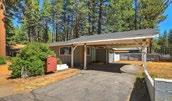

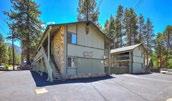

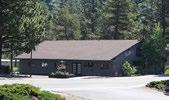


















Publisher’s note: This is one in a series of stories written by immigrants living on the South Shore. Names are being withheld to protect the individual who wrote the story and their family. Although my name will remain anonymous, I invite you to take a moment and think about what some people have called the “accident of birth.” The concept that not a single person on this earth was able to choose whether they would be born into this world or not.
One was also not able to pick the country one would be born into. We also weren't able to pick whether we would be born into a healthy environment in our household or be born into a broken home. Or whether our parents or guardians, or lack thereof, would be from the elite or from the working class, or whether we would be foster children. Let alone pick the level of education one’s parents possessed at the time of birth.
We also didn’t pick our gender and/or sexual orientation. Nor were we able to pick which citizenship status we would be born into, the color of our skin, the primary language(s) we were taught, whether we would have a disability, nor the cultures we would grow up with.
We are simply here in this world with all its benefits and/or liabilities the accident of birth has provided us.
Yet, some of us still roam this earth like a lot of those things mentioned above were earned, somehow. But please take a moment to think about the following questions: If you were born in a rural part of the world with no running water, no electricity and no access to education, would you have earned that? How about if you were born into the wealthy elite class living in the top floors of skyscrapers of the most important cities in this world with access to the most elite schools, would you have earned that? Or would it be a mere chance?
So, why then, do some people in some corners of the world seek to judge and criminalize people simply because of the circumstances they were born into? Especially when they are seeking better





opportunities for themselves and for their loved ones. Isn’t seeking better opportunities an instinctual thing to do, regardless of our background?
I am simply trying to shine a light on a reality and bring awareness to a situation that requires deep critical thinking and a higher level of compassion and understanding for one another, as human beings, and as sentient beings.
As someone from a mixed status household, I can tell you that things are a lot more complicated and nuanced than they may appear to be in your favorite news outlet. My father was a legal resident of the United States, originally from Michoacan, Mexico. My mother was an undocumented immigrant to the U.S., also from Michoacan, Mexico. Some of my siblings were undocumented and only I and one of my brothers were U.S. citizens.
The accident of birth at play, one might say. My dad had passed away when I was two years of age, leaving my widowed mother to fend for herself and her six children—a feat that not many people would be able to endure successfully.
I still remember when I was eight years old and Immigration and Customs Enforcement (ICE) came into our apartment looking for my mother and my undocumented siblings. My mother started crying. I did not understand what was going on, so I asked my mom what's happening, and she replied with tears in her eyes, “nos van a llevar” (they are going to take us). Not understanding what she
meant at the time, I thought to myself, take you where? Why?
I looked up to the ICE officers towering over me and asked them, “Why is my mom crying?” One of them responded with a dry response: “Because she's not allowed to be here.” Still, I didn’t understand what he meant. More questions came to my mind. Why weren't we allowed to be in the place we have lived our entire lives? This is our home, the only place I have ever known.
I remember my mother pacing around the apartment frantically looking for immigration paperwork and whatever she could fit in a small backpack while simultaneously telling my siblings to fit in a backpack whatever they could.
Fast forward a few days; I was in a detention center in San Francisco with my mother and my siblings. I remember the room was made of concrete, perhaps 12’ x 8’ x 10.’ Dark grey walls, with one bed for all of us, and it was extremely cold. It was almost like they were blowing the A/C at full blast at the lowest setting, not because it was hot that day, but rather, because they wanted you to feel uncomfortably cold.
To me, it was
no wonder they called it the ice box. Since I was underage at the time, and my mother had petitioned for me, I, too, was held in that San Francisco detention center even though I was a U.S. citizen. My family was ignored by ICE officials when we asked for food, water and to use the restroom. These requests weren’t considered until hours after our initial inquiries.
Only once have I ever felt less than human in my life, and it was at an ICE detention center in San Francisco in the richest country of the world. The free world if you will, as a U.S. citizen.
Fast forward to today; even though my mother, my siblings and I were deported to Mexico back in the late 1990s, I found my way back to the United States. Today, I am giving back to my community with an abundance of care and compassion, and still
believe in the American Dream. I have obtained an associate’s degree from Lake Tahoe Community College—a place that welcomed me with open arms as a non-traditional first-generation and low-income student at the time—a bachelor's degree and a master’s degree from some of the most prestigious universities in the world, and have helped hundreds of people obtain access to higher education. I now support those who didn’t have a say in their own “accident of birth” story, regardless of where they come from, what their citizenship status is, what their skin looks like, or what their background is. Freedom isn’t free and we must fight for it every single day. Oppression for one is oppression for all. Viva South Lake Tahoe!



As Tahoe temps rise, especially the overnight lows, residents are turning to air conditioning to cool off.
Barbara and Gary Cooper recently had Nixon Heating and Air Conditioning of South Lake Tahoe install their unit.
“The problem seems to be night temps are warmer and we can't leave windows open at ground level because of animals,” said Barbara Cooper, who lives in the unincorporated area of El Dorado County. “When it is really warm, we wake up and it is 60 outside.”
Another reason the couple installed the forced air unit is to combat smoky days when it’s impossible to open windows for natural ventilation.
It’s been in the last few years that the heat has started to be an issue for Becky and Roy Darrow who have lived in their Zephyr Cove home for 47 years.
“We put in a whole house fan last year and then followed up with air conditioning this year,” Becky Darrow said. “The fan works great once the sun goes down and the outside air cools down. But since our house gets full-on sun in the afternoons, the fan doesn't help at that time of day.”
The Darrows also own two office buildings in Zephyr Cove, which have had some type of cooling mechanism—air conditioners and evaporative coolers—for a number of years to contend with tenants using multiple computers and servers that create heat and need to be in a cool environment.
Thermometer readings
The National Weather Service in Reno reports the high temperatures in South Lake Tahoe in 2020, 2021, 2022, 2023 and 2024 are in the top 10 for highest maximum temps, with all being more than 90 degrees.
The mercury is read at Lake Tahoe Airport.

The highs were: 91 degrees in 2020, 93 in 2021, 92 in 2022, 93 in 2023, and 92 in 2024.
July is usually the hottest month of late, though it can be August.
The average normal highs and lows for South Lake Tahoe in June are 72 and 38 degrees, 80.4 and 42.5 in July, and 79.7 and 41 in August.
The highest overnight temp recorded at the airport was 62 degrees, which occurred in 1988 and 1970. The overnight lows are highest in June, July and August.
In 2015, 2021 and 2023 the highest overnight temp was 60 degrees, 55 in 2020, 58 in 2022, 57 in 2024, and as of mid-August 48 degrees for 2025.
Looking at the numbers
Anderson Heating & A/C of Carson City, the company the Darrows used, has seen a definite uptick in the number of A/C units being installed in the basin.
Rafael Hernandez, an estimator with the company, said they’ve installed about 30 air conditioners in Tahoe in the last two summers. That’s the same number Tilley Plumbing & Heating of Stateline has put in.
Both companies only work in Nevada. No HVAC company in South Lake Tahoe returned calls.
In older homes a concern is whether the existing duct and electrical systems can handle an A/C unit without upgrades because air conditioning requires more duct flow than heating.
“Since we were able to use our existing duct work, the air isn't as effective as it could be. But adding new ducts would have made the project more invasive and more expensive,” Darrow said.
Hernandez said another issue is homeowners’ associations can have rules about where the apparatus can go and how much noise it will make.
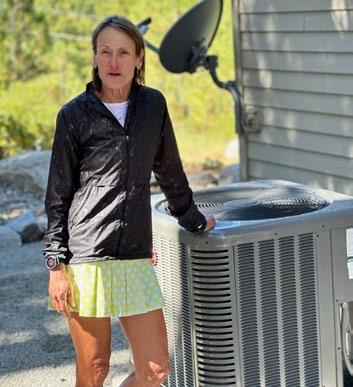
Nick Tilley, owner of the Stateline HVAC company, said people new to the area are more likely to add A/C, people who are accustomed to forced air and not opening windows at night.
This could be why real estate agents are also seeing an increase in the number of clients who want air conditioning already installed.

“People are asking about A/C when looking at homes now. Fifteen years ago, A/C was a non-issue, but with climate change and hotter temps, there is an interest in A/C,” Ginger Nicolay-Davis, a broker associate with Compass Real Estate in South Lake Tahoe, said. “I think we will continue to see the demand for A/C to rise.”
Some homes she has sold had mini splits as a cooling option, which allows for a single room to be cooled instead of the entire house.
Mike Phillips with Realty World in South Lake Tahoe is seeing bigger new builds coming with A/C, while it’s mostly out-of-towners requesting it.
Houses on the market on the California side with A/C had a median price of $996,000 compared to the overall median of $726,000, according to Phillips.
It’s not just Tahoe witnessing a spike in A/C units. According to the Energy Information Administration, in 2001, 77 percent of U.S. households had air conditioning, while in 2020, 88 percent did.
Based on how jurisdictions’ permitting systems are set up, officials say it’s difficult to provide exact numbers for A/C installs.
South Lake Tahoe officials estimate of the 155 new single-family permits issued in the last five years, between 80 and 90 included air conditioners, while five commercial builds did. Another 20 units are likely to have been part of remodels.
“Of the 8,780 permits from 2024, filtered for permits in SLT, there are 90 for mechanical, which A/C-HVAC fall under,
Continued on page 11
AIR CONDITIONING
Continued from page 10
both residential and commercial. Of those, eight appeared to be new A/C units,” Carla Hass, EDC spokesperson, said. Douglas County provided an assessor’s map with numbers, showing a handful of A/C or mini splits being installed at the lake since 2020.
What others say
Despite the increase in cooling systems in the basin, neither Liberty Utilities nor NV Energy have seen a surge in electrical use. This could be because the temperatures in the basin don’t require daily use of the units, unlike places like Carson City, Reno and Placerville.
“Our engineers reviewed summertime electric load demand over the last four years. They found that although there were occasional daily spikes, potentially caused by excessive heat and the need for cooling units, the overall trend was essentially flat. These results were consistent in both North and South Lake Tahoe,” Kurt Althof, Liberty’s regional communications manager, said.
A program expert at NV Energy said, “According to U.S. Energy Information Association, A/C accounts for nine percent of home energy use across all U.S. households, but in cooler climates like Tahoe that number is likely lower and may not be more than about five percent.”
NV Energy said no one on the South Shore has participated in its A/C tune-up or replacement programs from 2022 until now.
Air conditioning is not tied to any Tahoe Regional Planning Agency threshold or permit.
“The Climate Action Plan looks at the winter heat efficiency of homes and other buildings in the region as use of natural gas relates to the greenhouse gas emission inventory for the basin,” spokesperson Jeff Cowen said. “A/C uses electric power, which is produced outside the region. Climate change could continue to impact the communities and environment of the Tahoe basin and in new ways.”
TRPA’s building in Stateline had A/C when the agency purchased it.
The League to Save Lake Tahoe “encourages people to use the minimal and most energy efficient smart heating
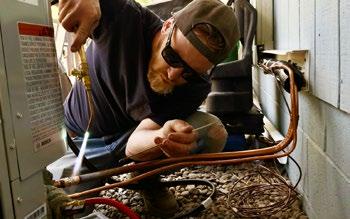
and cooling systems available, as well as incorporating passive design principles, in new construction and renovations.”
Communications Director Chris Joseph also said the nonprofit advocacy
group has done this at its new office. Insulation is made from recycled denim to reduce the number of days forced air—hot or cold—is needed.
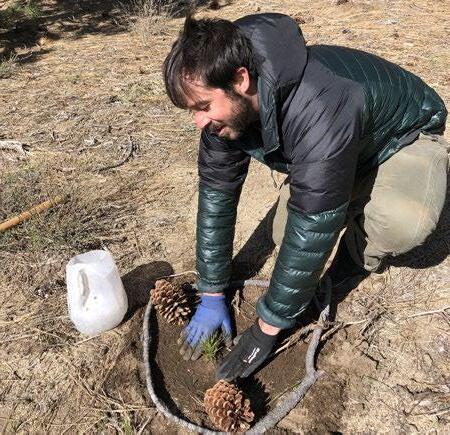
Do you know someone who has gone above and beyond the call of duty to protect the Tahoe Basin?
Nominate them for a Lake Spirit Award, honoring real people making real progress at protecting Lake Tahoe.
Nominations can be made at trpa.gov/awards through Tuesday, September 30, 2025.
For more information: Thea Schwartz 775-589-5251
tschwartz@trpa.gov www.trpa.gov
The Saint Joseph Community Land Trust helped local renters hang onto their longtime home after the owner decided to sell. The organization provided $100,000 In downpayment assistance for the structure and bought the land underneath the house that it is renting back to the new homeowners under a 99-year lease. The transaction is part of its new TAHOE (Tahoe Affordable Home Ownership Enabling) program.
The Boys and Girls Club is raising money for its snack program, which provides free, healthy snacks to any child age 5 years old to 18 years old, regardless of if they are enrolled in its program. Every donation up to $30,000 will be matched through October 31. Visit bit.ly/back-toschool-snack-2025 to donate. In 2024, the club served more than 42,000 snacks.
Donate blood Sept. 12 from 11:30am5pm at the South Lake Tahoe rec center, 1180 Rufus Allen Blvd. South Lake Tahoe’s Multicultural Celebration is Sept. 13 from 11am-3pm at Bijou Community Park.
When it comes to 2024 cannabis sales per capita El Dorado County was third at $243. Mono and Inyo counties were first and second, respectively. EDC had $46.3 million in taxable sales, putting it at No. 22 out of 43 counties.
Here (https://shorturl.at/xE37C) is the environmental impact statement scoping summary report for the proposed Barton Hospital project in Stateline. TRPA estimates this winter it will circulate the draft EIS for public comment.
On Oct. 10-11 the Tahoe Literary Festival will be in Tahoe City.
Caesars Republic isn’t just a Stateline thing. In August, Dry Creek Rancheria and Caesars Entertainment broke ground on a project to turn River Rock Casino into Caesars Republic Sonoma County.

The U.S. Geological Survey has released a series of topographic maps (https://shorturl.at/JtE7H) designed to be user-friendly for the average person enjoying the outdoors.
Scientists report 13 active osprey nesting sites in the Tahoe basin; an improvement from the early 1980s when few nests existed. Osprey build nests in dead trees at Emerald Bay, D.L. Bliss State Park, and the East Shore. These raptors, which are protected under the Migratory Bird Treaty Act, migrate south in winter.
Douglas County’s stormwater division on Sept. 17 at 3pm at the CVIC Hall located at 1604 Esmeralda Ave. in Minden is hosting a workshop to discuss open space inventory, stormwater system assets, maintenance successes, ongoing capital projects, and long-range funding strategies.
Oct. 12 from 8am-1:30pm is the Meyers Outdoor Gear Swap in the Westgate parking lot adjacent to Divided Sky/Cool Beans.
Nevada Division of State Parks and the Nevada Division of Outdoor Recreation want to know what you think of the 2027-36 Statewide Comprehensive Outdoor Recreation Plan The survey is open through Sept. 15: parks.nv.gov/scorp.
Approximately 12 miles from Meeks Bay to Tahoe City is now called the Dianne Feinstein West Shore Tahoe Trail in honor of the late U.S. senator from California who was a champion for all things Lake Tahoe.
Individuals and small business owners may participate in Liberty Utility’s electric vehicle charger rebate program. For more info, go online (https://shorturl. at/c2Y0K) or call (530) 543-5286.
South Tahoe PUD is celebrating its 75th anniversary Sept. 24 from 4-6pm at 1275 Meadow Crest Drive with treatment
plant and big truck tours, history, memorabilia and refreshments.
The 110 employees of Beach Retreat & Lodge in South Lake Tahoe are losing their jobs with the purchase of the property by a group that includes Lloyd Goldman, a member of the Goldman real estate dynasty. The former Timber Cove Lodge was built in 1975 and part of the real estate holdings of Bob Maloff (1921-2011). It became the Beach Retreat & Lodge in 2012. In 2019, Seller Linchris Hotel Corp. bought the South Lake Tahoe lakefront property for $27.9 million. The current purchase price has not been disclosed.
September is Suicide Prevention and Awareness Month. People experiencing a mental health crisis, or their loved ones, may call or text 988. Go online (https:// shorturl.at/quUNY) for local resources.
Lake Tahoe Basin Management Unit implemented enhanced campfire restrictions now through Nov. 30, or until rescinded. For details, check out this map: https://shorturl.at/Kxw4w.
Consultant and former longtime Republican congressional staffer and US Navy veteran Scott Bensing has joined the Tahoe Fund Board of Directors. He also serves on the board of the Tahoe Transportation District as the state of Nevada appointee.
On October 9, the El Dorado County Food Market in conjunction with Bread and Broth will be hosting a free Farmer’s Market to provide fresh fruits and vegetables to eligible clients. Drive-thru pick-up from 10am to 11am at St. Theresa’s Catholic Church.
The Tahoe Transportation District has hired Tyler Wood as capital projects manager.
The Tahoe Area Mountain Biking Association is hosting a trail day along the Panorama Trail on September 20 at Heav-

As we continue doing the work to make our system more resilient to extreme fire conditions, we also use three key strategies to safeguard our communities against the threat of wildfires. While these measures help to keep us all safe, they can lead to power outages. We want everyone to be aware and prepared.

enly in conjunction with Tahoe Pride and the US Forest Service. For more information, visit https://tamba.org/event/tahoe-pridetrail-day/?mc_cid=4d7d7a0e45&mc_eid=6289a92ee2.
`The Tahoe Regional Planning Agency is accepting nominations for its Lake Spirit Awards through September 30. The awards honor individuals exhibiting an exceptional commitment to Tahoe’s environmental health, including community members, volunteers, public officials and scientists. Visit https://www.trpa.gov/ how-we-operate/awards/#spirit for more information and to submit a nomination.
Locals utilizing the Emerald Bay Shuttle (see story, p. 16) will receive a 20 percent discount through October 15. Visit emeraldbayshuttle.com to purchase tickets.
Tahoe PAWS will be hosting a Hand & Foot Tournament on September 15 at 5:30pm at the Valhalla Grand Hall. Donation, $20.
Tahoe Together and the Smaine Foundation are hosting the inaugural Tahoe Games Mountain Sports Festival at Caesars Republic September 27-28. Music, big air, kid bike jump jam, art, food trucks, adventure gear vendors and lots more. Free.
CASA El Dorado is hosting a Family Fun Day fundraiser on September 27 from noon to 4pm at the Hangar. Games, crafts and more. Free.
The South Tahoe High School Homecoming Parade rolls through town at 4:30pm on October 3.
Got a community item for Heard? Email mountainnews2@gmail.com, subject line “Heard.”

1| 2| 3|
FIRE SEASON SETTINGS
Sensitive settings on power lines to reduce wildfire risk.
PUBLIC SAFETY OUTAGE MANAGEMENT

Proactive de-energization ahead of extreme wildfire risk conditions.
EMERGENCY DEENERGIZATION

Turning off the power when a wildfire gets too close to power lines to prevent secondary fires.
Visit nvenergy.com/PowerSafeNV to learn more about these strategies and how to be prepared for extended outages during this time of heightened fire risk.
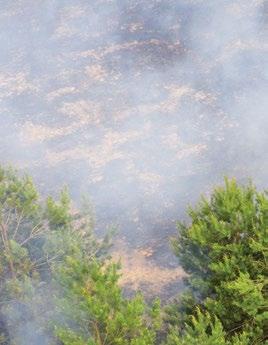


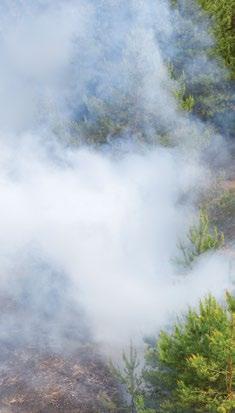


According to Joe Ernst, the ECHL’s VP of Hockey Operations, the Tahoe Knight Monsters ECHL hockey team had “a really good first year to build off of with a lot of positives,” notably, “great fan support.”
The TKM are here to stay, part of the community for the foreseeable future, so I thought I’d get educated on how the economics work to sustain an ECHL team and how league revenue as a whole works.
Ownership & Management
Some ECHL teams are owned by individuals as partnerships, some are owned by corporations, and some exist as a mix of these. The TKM, as near as I can tell, is owned by Tim Tebow, along with David Hodges, and Chip and Joanna Gaines.
Zawyer Sports & Entertainment (whose owner and CEO is Andy Kaufmann) manages and operates the TKM but also has a larger stake in the world of sports. According to its website, ZSE also “owns and operates the Jacksonville Icemen, Savannah Ghost Pirates, Greensboro Gargoyles, Charlotte Checkers, Gastonia Ghost Peppers, the Community First Igloo, The UpShot League, a new professional women’s basketball team plus the first four teams in (that) league.” I’ll note that the Gargoyles’ ownership also includes members of the popular Spittin’ Chiclets

podcast (part of Barstool Sports) and J.J. Jansen, a long-time NFL Carolina Panther. According to Anthony Benge, senior vice president of sales for the TKM, team owners and ownership groups view their investment as they would any other business; it needs to run at a profit.
But how exactly is that accomplished?
ECHL Finances
The economics of an ECHL team and the league itself are complicated. The ECHL does not use the NHL’s revenue sharing model, which spreads some of the wealth from more lucrative franchises with those on the lower end of revenues. For an ECHL team, the primary revenue streams are through fan engagement (tickets, merchandise, etc), sponsorships, and various partnerships. Some revenues also come from the league’s partnership with FloSports, the media company that streams ECHL games, and is split evenly among the 30 teams, according to Joe Ernst, VP of Hockey Operations for the ECHL.
The support that comes from affiliates (such as the Vegas Golden Knights and Henderson Silver Knights for TKM) isn’t necessarily financial. Ernst explained that the movement of players down to the ECHL team is one byproduct of affiliation. The NHL affiliates also provide occasional entertainment links (such as the visiting Golden Knight mascot and others), jersey elements that reflect the parent team and so on. According to Ernst, players are paid by whomever holds their contract: if they’re on a TKM contract, they’re paid by the TKM’s ownership
group; if they’re on a VGK or other pro contract, then they’re paid by that organization. There are variations in which players are paid a daily rate by the ECHL team when sent down by the affiliate. Coaches and support staff for the TKM are paid by Zawyer Sports & Entertainment. Barton Health pays the salaries of the TKM’s strength and conditioning coach and athletic trainer.
Team Finances
Benge said that travel and player housing typically make up the largest costs for an ECHL team, but salaries and health care factor in significantly. According to my research, arena rent (in this case, the TBEC), is far and away the largest cost for most ECHL teams. In some ECHL scenarios, the team pays rent to the city for use of the arena, and then they divide up the food/ beverage sales, the suite revenue, the naming rights and parking at various percentages. Here in SLT, the TBEC is owned by the Tahoe Douglas Visitors Authority.
During a three-way phone call, neither Kevin Boryczki (general manager for the TBEC) nor Alex Reed (director of Communications for Zawyer Sports) would disclose what the TKM is paying in rent as the TBEC’s only regular tenant.
Boryczki and Reed did confirm some general revenue divisions between the TBEC and the TKM.
The TBEC captures revenues from food/concession sales and of course, the rent. There is also a $4 per person surcharge built into the original plan to offset traffic impacts by funding LTVA’s Lake Link public transit and other environmental mitigations. This cost is passed along to patrons as a “facilities fee.”
Regarding this public transit commitment, I’ll add that while there is now service in the tourist corridor as promised, the county, which houses many regular TBEC attendees, has been left
out of the loop unless people want to drive and park in a secondary location in town.
For their part, the TKM capture revenues from gate receipts, Ticketmaster sales (excluding fees) and merchandise. There are also “rebates” from Ticketmaster that teams sometimes receive based on how they use the service.
Figures provided by Jeanna Rangel of the TDVA indicate that the TBEC’s net revenue from the Knight Monsters’ 2024-25 inaugural season was $845,958, which was for 36 regular season home games and four playoff games. If we average that cost to the TKM across those 40 games, it amounts to $21,148.95 per game. The TKM would not disclose what they capture in gate revenue per game.
According to Hockeydb, the TKM’s average attendance was 3,427, which ranks 23rd of 29 teams in the league. Exact figures on average ticket price are unavailable, but it seems to be around $30. It’s unclear if this takes season tickets and suites into account, but using this attendance average and approximate ticket rate, revenue per game would be a little over $102,000.
Inquiries about what percent of season tickets were purchased by residents this past season have gone unanswered.
A farewell . sort of
In closing, I’d like to pass on my well wishes to Anthony Benge, one of the folks you’ve seen in the foyer greeting and assisting fans at every game, as he heads off to work with the Greensboro Gargoyles. He will still be involved with the TKM and some other teams as part of his duties under Zawyer Sports & Entertainment.
As always, feel free to email mikesmutterings@gmail.com
For several years now, Gardner Mountain resident Kristi Bell noticed her neighbor was feeding bears and other wildlife. She called in a complaint to California Fish and Wildlife and state personnel came and talked to the neighbor, who denied feeding the bears, on more than one occasion, though no further action was ever taken. It all came to a head a few months ago when a bear broke into Bell’s house through her French doors and made a mess in her kitchen. Suspecting a bear that had become habituated through her neighbor’s feeding, she filed a report
warden dedicated to Tahoe. The nearest warden must drive up from Placerville to take a report or do an investigation or address a bear-feeding situation, so doesn’t respond to every incident and isn’t on patrol in Tahoe looking out for problems in general.
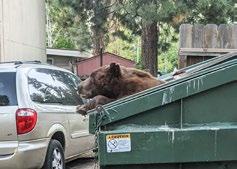
Toogee Sielsch
Dumpsters are one of the top unnatural sources of food for bears.
with the El Dorado County District Attorney’s Office requesting prosecution for feeding bears. The penalty for feeding a bear in California is a $1,000 fine and possible jail time. To strengthen her case, Bell provided photos she took of her neighbor actually feeding the bear. The response from the DA’s office thus far— radio silence.
This is not unusual, said Ann Bryant executive director of the BEAR League. Bryant says her organization receives an average of ten calls a week about people feeding bears. Rarely is a case prosecuted by the local DA. Prosecutors pay a little more attention if the report comes through the BEAR League than from a private citizen, said Bryant, but actually filing charges against someone is infrequent. Bell is urging community members to call the El Dorado County DAs office and advocate for more pursuit of such cases. Various factors complicate moving more forcefully against those found to be feeding bears and other wildlife. Cases can only be referred for prosecution by CFW, so making a report through the local police or sheriff won’t get anyone anywhere. Also, there is not a CFW
Wardens are often reluctant to refer a case for prosecution because charges are so rarely filed. Kathi Zollinger, South Shore team leader for the BEAR League, convinced a warden to refer a different bear-feeding case for prosecution a few years ago. The El Dorado County District Attorney declined to file charges. The situation continued and she appealed to the warden to try again. He resisted, said Zollinger, saying his previous attempt was rebuffed by the DA. Local bear autodidact Toogee Sielsch said he “would love to see some sort of legal repercussions” for those who feed bears. Reducing bears’ unnatural and dangerous habituation isn’t going to work, though, if bears can just wander from one jurisdiction in the basin to another that may have more lax regulations or enforcement, he said. “They all need to be on the very same exact page with ordinances and enforcement.” The biggest offenders are restaurant and apartment building owners who don’t secure their dumpsters, said Sielsch.
Administratively, El Dorado County will require a property owner to install a bear box if a bear is continuously getting in their trash. Bryant said VHR owners need to make it abundantly clear to their clients that feeding bears is illegal and trash must be disposed of properly and securely. New and uninformed people cycling in and out of the basin and its neighborhoods makes the public education component more difficult, said Bryant.
Zollinger said, “I wish that people realized the damage they’re doing with feeding bears. It’s dangerous for humans and it’s dangerous for the bears. This is a serious issue.”
Representatives from the El Dorado County District Attorney’s Office and the California Department of Fish and Wildlife could not be reached for comment by press time.

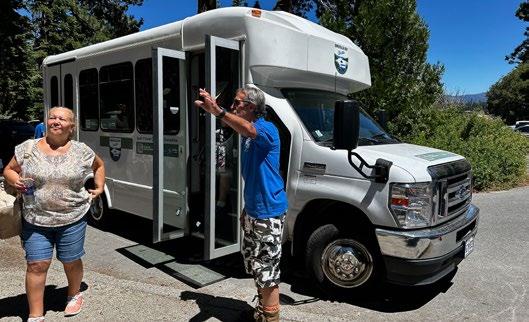
The goal, though, is to start small and expand the offerings, with the virtual elimination of parking a future possibility.
The California Highway Patrol is being paid $10,000 by Sierra State Parks Foundation for special enforcement in the area every Friday through Sunday.
In the first four weeks of shuttle operations, officers issued eight moving violations, 157 parking citations, and had 13 vehicles towed.
Parking tickets per El Dorado County ordinance cost on average $100. Whether this is a deterrent remains to be seen. El Dorado County Supervisor Brooke Laine believes the fines need to be increased.
Riding back to the Y on a Saturday afternoon, this reporter noted a CHP officer placing tickets on multiple vehicles for parking illegally. Some were in areas posted as no parking, some had tires in the lane of traffic.
The CHP office in Meyers did not readily have stats for tickets issued in prior summers. Nor were figures for vehicle and vehicle-pedestrian accidents at Emerald Bay provided as of deadline.
Continued from page 16
Downtowner, the company that operates the microtransit service on the South and North shores, operates the Emerald Bay Shuttle. The three-month stint costs $404,000.
The vans, some of which have ca-
that culminated in this pilot because they all agreed there is a parking problem at Emerald Bay.
Caltrans involvement included placement of the physical barriers to prevent illegal parking along the shoulders of Highway 89 and sign installation.
It’s the League that first brought microtransit to South Lake Tahoe in 2018,
others behind the wheel discretion. For instance, when thunderstorms chased people out of the mountains in July, he was able to pick people up who didn’t have a reservation. He also allows those with reservations to take an earlier shuttle if space permits.
For Laine, she is already planning on this trial extending another year or two.
Francesca Behling is hooked.
“I never imagined going to Emerald Bay without a car,” the South Lake Tahoe resident said. “We all could look at the lake without having to drive.”
Behling and her four out-of-town friends were riding the Emerald Bay Shuttle from the Y transit center to Eagle Falls parking lot. This particular Saturday in August was her first time on the van, which seats 13.
As a proponent of public transit, she hopes this becomes a permanent option.
Driver Dale Cabral says a good number of locals have been his passengers.
For Tracy and Craig Brickwood of Australia, it took a quick internet search to figure out how to get to the Emerald Bay area without their vehicle. The couple had driven around the lake the day before and witnessed the nightmare on Highway 89, so they wanted to avoid it.
They easily used the app to book the round-trip shuttle, which cost them $10 each. The need for reservations didn’t faze them, as that has been the norm on their travels through U.S. national parks.
When Chris Sorg of Santa Rosa saw a story about the shuttle on his local TV news, he knew he and his wife and
another couple would be on board. They booked it two days in advance.
The 9am departure was perfect for the foursome.
“Otherwise, we would have had to have gotten up much earlier to get parking,” Sorg said.
The nuts and bolts
While the shuttle hasn’t eliminated the chaos and congestion at Emerald Bay, it is taking a few vehicles off the highway and gives those who don’t want to contend with the parking debacle an opportunity to visit without the hassle.
This inaugural pilot shuttle runs July 15 through October 15. In the first month 3,240 riders accounted for the 1,025 bookings. (A person can make a reservation for a group.)
Pick up points include Sugar Pine Point State Park, Camp Richardson ice cream store and the Y. All drop off at the U.S. Forest Service parking lot at Eagle Falls, which costs $5 to park at if you drive there. Parking costs $10 a day at the Vikingsholm lot, or $3/hour.
Most of the riders (1,699) started at Camp Rich, 852 at Sugar Pine and 689 at the Y.
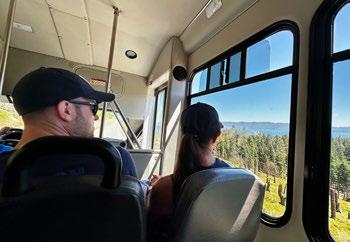
The shuttles can transport almost 350 people on a weekend day. (More shuttles run Friday through Sunday.)
Considering 1.5 million people visit Emerald Bay every year, this transit program might not even be making a real dent in the problem.
It wasn’t until earlier this summer that Caltrans conducted a road safety audit to determine traffic volumes and pedestrian safety issues in the Emerald Bay area. The shuttle didn’t start until July, so Caltrans could have time to ascertain that baseline information, which will be used going forward in making future decisions about this stretch of state highway for which it is responsible.
Continued on page 17
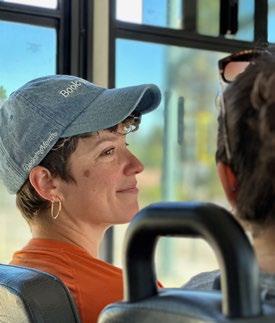
pacity to haul bikes, run at various times based on the day of week and departure point. (Details online: https://shorturl. at/9kxJt.)
Money for the transit project comes from: $150,000 each from League to Save Lake Tahoe and Tahoe Fund, and $100,000 in anticipated fares. The big red barriers by Inspiration Point cost $30,000, paid for by Tahoe Regional Planning Agency mitigation funds for El Dorado and Placer counties.
Who all is involved
Laine lined up the players who bought into her concept of the Emerald Bay Shuttle. As a lifelong resident of South Lake Tahoe, she is well aware of the problems in this area.
After reading TRPA’s Highway 89 Corridor Management Plan, she came up with the plan. Laine asked Lake Tahoe Basin Management Unit Supervisor Erick Walker, Rich Adams with California State Parks, and Caltrans if they had read the study. No was their collective answer. She gave them each a copy.
Laine convened a meeting involving more than 13 agencies on June 27, 2024,
and has wanted to be part of the Emerald Bay solution for years.
“… the illegal and unsafe roadside parking causes direct and indirect environmental damage. Our reliance on private cars results in sediment and tailpipe emissions clouding the lake, parking on dirt destroys vegetation and adds to erosion of fine sediment into the lake, social trails for dispersed parking causing erosion and results in litter left behind,”
Gavin Feiger, the League’s policy director, said. “Getting people out of their cars and on to transit and eventually bikes and walking helps keep Tahoe blue. The roadside parking also creates safety issues and makes the experience of visiting one of the most beautiful places in the country less enjoyable.”
What happens next?
Once the project is over, the stakeholders will figure out the next steps.
Riders are asked to take a survey when their trip is complete, so that information will be part of the equation.
Cabral, one of the van drivers, said Downtowner has been quick to implement changes on the fly, and allows him and
“We are planning on a 2026 pilot project which will add additional barriers to parking illegally, introduce waterborne transit as another way of visiting Emerald Bay, and might also include a reservation system for the limited amount of paid parking allowed on USFS and State Parks parking lots,” Laine said.
She added, “The high percentage of people returning (in) the direction they came from indicates that a mobility hub with a transit system can be an effective way to reduce the number of people arriving by their personal vehicle.”
Local CHP spokeswoman Ruth Loehr believes to change human behavior it is going to take education, enforcement, and engineering.
“We need to continue to educate the public regarding the dangers of illegal parking in the area, both from the safety lens, and from an environmental standpoint,” Loehr said. “We must ensure the
public is aware of the shuttle program and continue to increase ridership. We have been and will continue to enforce the illegal parking in the area with appropriate enforcement action. Sadly, as soon as we remove a vehicle and continue down the road, another motorist will just take the empty spot. We cannot be everywhere all at once. Physical barriers to eliminate all shoulder parking in the designated no parking areas will go a long way.” Where the money comes from remains to be seen.
“There is not public money for recreation-focused travel and nonprofits can’t fund it forever, so it will need to be funded by ridership and contributions from local entities that are benefiting from the service,” Feiger with the League said. Still, the League is optimistic a more robust program could alleviate this parking mayhem.
“The 2020 Corridor Plan estimates that up to two-thirds of current visitors to Emerald Bay could shift to transit,” Feiger said. “Over the next few years, we hope to expand the service and ridership along with increased parking restrictions and enforcement to get to the point where the service is self-sustaining.”


We have all heard the slogan “Keep Tahoe Blue.” However, in order to keep Tahoe blue, we need to keep our forests green says my father John Pickett, the founder of the Sugar Pine Foundation. Keeping Tahoe’s forests green, in other words restoring our forests, has been the primary mission of the Sugar Pine Foundation for 20 years. The Sugar Pine Foundation is a group of people who took the initiative to follow their passion for environmental preservation. Among them were my parents - Maria Mircheva and John Pickett. My father came up with the idea to start a non-profit organization and my mother carried it through through community organizing and partnership building. Keeping our Forests Green Forest health is very close to our hearts as a mountain community. The forest filters water going into our beloved Lake Tahoe and it also provides habitat for wildlife and is a source of tranquility and inspiration for our people. Lots of work has been done to reduce the density of trees to prevent the fast spread of fires, but it is also important to restore the forest composition. That means having young and old trees and

a variety of species as well. That is why saving sugar pines and other white pines from the spread of white pine blister rust (a non-native invasive disease) is essential to preserving forest diversity. The more species a forest has, the more resilient it is from stressors such as drought, diseases and fires. Just as different aspects of our ecosystem depend on each other, 20 years of The Sugar Pine Foundation's achievements would not be possible without the work of thousands of volunteers, partners and funders. Over the past 20 years, 15,000 volunteers and field crews planted 250,000 trees on 4000 acres.
Our Roots
The story of the Sugar Pine Foundation began in 2004, when my father, John, was working for the US Forest Service studying the effect white pine blister rust. Seeing that only three percent to five percent of Sugar Pines and Western White pines possess a natural immunity to the fungus, he founded the Sugar Pine Foundation to plant the seedlings of resistant trees. In the fall of 2005, my father collected cones from the first 100 candidate Sugar Pine trees to be tested for immunity. He met my mother in 2006 when he led a project for the Tahoe Baikal Institute, a youth environmental exchange program with Russia. After my mother, Maria, completed her Master’s in Environmental Science in 2007 from UC Santa Barbara, she joined my father’s sugar pine restoration efforts. She became the exec-
utive director, wrote grants, hired part-time staff and made the dream come true.
Rising from the Ashes
In the early years of the Sugar Pine Foundation, the Angora Fire burned over 3,000 acres in South Lake Tahoe which had devastating aftereffects; however, it presented an opportunity for reforesting Sugar Pines in an area that was heavily logged in the Comstock mining era and lacked a diversity of native trees. The first 3,000 trees planted are now reaching 20 years old. The Tahoe area is very prone to fire, and over the 18 years since the Angora Fire, the Sugar Pine Foundation has also reforested areas burned in the Gondola Fire, Emerald Fire, Little Valley Fire, King Fire, Tamarack Fire, and the giant Caldor Fire. Reforesting burn areas with a mix of native conifer species became the new mission of the Sugar Pine Foundation.
A World Record
In the spring of 2010, the Sugar Pine Foundation participated in a Guinness-world-record-breaking planting. Partnering with Tahoe Donner Forestry, 70 volunteers planted 360 Western White Pines and Red Firs in one hour, which combined with hundreds of other groups organized by the Sustainable Forestry Initiative, led to over 200,000 trees planted in just one hour. Initiatives like this one highlight the importance of international collaboration to save our forests and the impact people can make while working towards a goal together.
Leaving a Legacy
While cone collecting and planting is how the foundation began, “planting the seed of conservation in people's minds” is the most important according to my mother. One of the ways the Sugar Pine Foundation
works towards this goal is through leading school field trips. Partnered with the South and North Tahoe Environmental Education Coalitions, the Sugar Pine Foundation has helped many Tahoe students go on their first tree planting, boating, or snowshoe field trip, to experience and learn about the wonders of the outdoors. The foundation also funded the writing of the book The Happiest Tree in the Forest by local author Michelle McLean and illustrator Ana Valdez. It tells the tale of Lambi, a sugar pine and its animal friends. By working with youth, the Sugar Pine Foundation hopes to help inspire the next generation of environmental stewards.
A Personal Perspective
Growing up alongside the Sugar Pine Foundation, my love for the environment was built from being involved in restoration efforts alongside my parents. My first word was “stick” as I was playing with sticks in the forest while my parents were working. All my life, I was involved in planting seedlings, climbing trees to collect seeds, watering in the summer, and teaching people about the forest, so this experience developed an integral part of my character. As the next chapter of my life begins, I’ll take with me the 18 years of lessons from watching the Sugar Pine Foundation grow and follow my passion for ocean conservation at University of California, San Diego. You Can Help
Twenty years is just the beginning of the Sugar Pine Foundation's story because as a Chinese proverb says, “the best time to plant a tree was twenty years ago, and the second best is today.” You, too, can plant a tree with the Sugar Pine Foundation and create life in the forest this fall. Check the website calendar at sugarpinefoundation. org for planting events in October.
Birthdays are the best. I like celebrating mine and others’. How often do you get a day where it’s just about you?
Considering I’m turning a year older this month, it seems appropriate I share my favorite birthday dessert with you.
Growing up, mom allowed the four of us kids on our birthdays to pick what we wanted for dinner and dessert.
This tradition started with her parents. With mom’s birthday between Christmas and New Year’s, her parents made a point of making sure it was not lost among all the other celebrations.
While my birthday dinner requests changed, my desired dessert never did.
The No. 1 dinner was fondue. Not the gooey cheese, but the gurgling pot of peanut oil where with special forks we would cook meat, shrimp, and veggies. Eventu-
ally the oil was swapped for broth, making it healthier. This also meant it could be turned into soup at the end.
Other birthday dinners were shrimp and fries, and dad’s barbecued chicken.
Truly, the best chicken. Even better when there were leftovers that wound up in my lunch sack. (Mom made the best lunches and did so through my senior year of high school.)
My favorite birthday dessert to this day is homemade chocolate chip ice cream and chocolate cake with chocolate frosting. I’m fine with a box cake, but I do prefer homemade frosting. There really is nothing like homemade ice cream. While I’ll share the recipe, forgive me if I’m a bit stingy on sharing the actual ice cream.

Beat eggs in mixer. Gradually add sugar to eggs, beating until mixture is very stiff.
Turn mixer to lowest setting; then add liquids and salt. Mix thoroughly.
Pour into gallon freezer. (Good idea to have the empty container in the freezer a few hours before making the ice cream.)
Follow directions on your ice cream maker. Ice and rock salt are for the freezing process.
Grate chocolate on side used to zest lemons. It's OK to have some big chunks so you don’t add your skin to the chocolate.
As the motor starts to labor (15-30 minutes), look to see if the concoction resembles ice cream. If it does, use large spoon to make a sizable hole on two sides, putting that vanilla ice cream in a bowl and freezing it. In the holes pour in the grated chocolate.
Continue to churn the ice cream for 5 minutes or so until thoroughly mixed or motor turns off—assuming your machine does that.
Eat immediately, freeze the rest in the container without the dasher—that’s the part that turns the ingredients.




2030 DUNLAP AVE AT THE “Y”
OPEN DAILY 9am-8pm (530) 541-7788

NATURALFOODS MARKET
SCAN FOR OUR CURRENT SPECIALS

Groceries, dairy, bulk food, organic beer and wine, coffee, energy bars, cereal, snacks, body care products
PRODUCE DEPARTMENT
One of the largest selections of organic produce at Tahoe NUTRITIONCENTER
Complete selection of vitamins, supplements & herbs
To the editor,
Yesterday our Pilates Class was moved from inside the Kahle building to the park outside the building due to maintenance.
A likely ICE agent, with a big gun hanging at the hip was patrolling the site looking for.. minorities, I suppose.
I cannot get rid of the image as it reminded me too much and too painfully of the German occupation of our town in France, about the same size of South Lake Tahoe from 1940 to 1945. There were also soldiers patrolling the streets
and asking for IDs. The regular German soldiers were dressed in green and the Gestapo secret police in black (no mask). NEVER, NEVER did I think I would see a repeat of my 4-8-year-old childhood nightmare!
How can anyone support such government? How can we repeat the mistakes of not that long ago? Catastrophe awaits us?
Leon Malmed, Holocaust survivor, South Lake Tahoe
It's your community. We want to hear from you. Write us a letter and email it to: mountainnews2@gmail.com, subject line “Letter.”

Payroll data released by the state shows a division chief with South Lake Tahoe Fire Rescue was the most highly paid city employee in 2024 because of $107,739 in overtime. Information released by the state listed employees by position, not name.

The person’s base salary was $164,868, with other pay being $11,695 for a total of $284,302. This person accrued $29,696 in benefits, too.
State Controller Malia Cohen released the self-reported payroll data on June 25. This covered 746,358 positions, with total wages reaching nearly $67.28 billion for city and county employees in California. Twenty-two cities and two counties did not report info, or it was inaccurate.
Hayward at $146,215 had the highest average city employee wage, followed by Atherton, Beverly Hills, San Francisco, and Half Moon Bay.
Truckee came in at 119th out of 461 cities for the highest average salary
at $81,985. South Lake Tahoe was ranked No. 132 with an average salary of $79,580. Truckee’s average retirement and health benefit was $24,957 a person, while South Tahoe’s was $22,840.
Data shows South Lake Tahoe’s 335 employees received total wages of $26,659,133 in 2024, of which $21,255,229 was regular pay, $2,600,658 in overtime, $625,199 in lump sum payments, and $2,178,047 listed as other pay. Other pay could include car allowances, meeting stipends, incentive or bonus pay.
Health and retirement contributions came to $7,651,308.
The other top four paid South Lake Tahoe employees are:
• City manager: $224,347 base pay, $22,197 lump sum, $7,487 other pay totaling $254,031. Plus, $68,524 in health and retirement benefits.
• Fire battalion chief: $154,868 regular pay, $67,110 overtime, $10,297 lump sum, $21,198 other, totaling $253,473. Retirement-health benefits, $73,094.
• City attorney: $216,072 regular pay, $21,081 lump sum, $7,341 other, totaling $244,494. Retirement-health, $63,381.
• Assistant city manager: $201,741 base pay, $20,466 lump sum, $16,444 other, totaling $238,624. Retirement-health, $64,512.

















Despite the record amount of pollution that didn’t reach Lake Tahoe last year, the annual average clarity in 2024 was only 62 feet deep. Clarity was 72 feet in 2023 and 68 feet in 2022.
in 2011 as way for both states to restore and enhance the lake’s water clarity to historic levels of at least 78 feet by the end of 2031. The ability to see to a depth of 100 feet is the ultimate goal.
then-President Bill Clinton, more than $2 billion—mostly taxpayer dollars—has been spent in the name of lake clarity initiatives.
•Hearingbutnotunderstandingcertainwords?
•Difficultyfollowingconversationinnoisysettings?
•Frequentlyaskingpeopletorepeatthemselves?
•NeedtheTVorRadioturneduptoahighvolume?

A report released in August by the Lahontan Regional Water Quality Control Board and the Nevada Division of Environmental Protection reveals an estimated 727,000 pounds of fine sediment, more than 5,800 pounds of nitrogen and nearly 2,100 pounds of phosphorus were prevented from entering the lake last year. These are all annual record highs since 2016. Those numbers are the equivalent of about 29 dump trucks.
These pollutants fuel algae growth and are known to reduce Lake Tahoe's clarity and quality.
The total maximum daily load, or TMDL, program began
The bi-state report found Caltrans, NDOT, El DoradoDouglas-Placer-Washoe counties, and South Lake Tahoe exceeded their pollutant reduction targets by restoring wetlands and streams, limiting dust from roads and construction sites, and improving stormwater systems.
Compared to when baseline levels were taken in 2004, fine sediment reaching Tahoe has decreased by 29 percent, nitrogen by 23 percent, and phosphorus by 17 percent, according to Lahontan and NDEP.
Since 1997, when the annual environmental summit at Lake Tahoe was launched by
The 2024 Lake Clarity Report released this summer by the UC Davis Tahoe Environmental Research Center shows all these efforts are not having the intended effect. In fact, last year was the lake’s third cloudiest year on record.
Scientists admit they don’t know why the lake is getting murkier.
“Given that water clarity has not shown an overall trend toward improvement in several decades, we suggest that understanding the nature of the particles is a priority area for research to identify the current drivers of water clarity,” the conclusion of the 17-page report states.
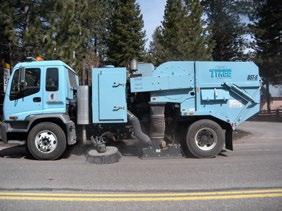
The report also said it’s time for more research to “understand the relative contributions of different particles, such as inorganic sediments, terrestrial organic debris, and phytoplankton,
overall
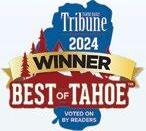




If you are wondering, I’m having a soul-expanding, mind-leaping summer—surrendering myself to savor it, rolling the jawbreaker in my mouth as it transitions from tart to sweet. The prankster heart releases delicious pain of love unexplored, hidden and safely tucked away, until it’s not. It’s easier now, fending off punctures, poisonous barbs and invasion by insatiable insects, rodents and humans. And this all arrived through the simple accident of discovering a kindred spirit— Jamaica Kincaid, author, gardener and overripe senior delinquent.
I stumbled upon her on my daily slog across the New York Times. She literally hopscotched off the page. There, in the midst of political puffery, elitist Hampton-Martha’s Vineyard summer lifestyles, the flavor of the month actress, movie, influencer, teased the headline: “Jamaica Kincaid never lost touch with the mischievous creativity of her seven-yearold self.”
I instantly recognized my doppelgänger. We could be twins, except she’s over six feet and Black and I’m under five and a half feet and (almost) white. Despite societal rules and tried and truly tedious goals, we continue to “bumble through time, grasping for meaning.”
How do we find meaning? By racing around the Monopoly board, grasping for every token? Or the same way any seven-year-old does—by being openly receptive to life and “sumptuous slow thinking.” Lingering over our thoughts like plums ripening under the benevolent gaze of a summer sun. Somewhere along the way, we swallow the rationale of becoming an adult. Which the Australian Institute of Family Studies describes as “the time you get serious about the rest of your life.”
This is the main reason I refuse to go to Australia. The other reason is the surface swings between 250 degrees Fahrenheit during the day and minus 400 degrees at night.

Wait. That’s the moon. But anyone who has traveled to Australia would say it’s hard to tell them apart.
Years ago, I made the common mistake of choosing an occupation where I was forced to work with adults. And over the time they spent enduring my rants, hoots, and disruptive laughter, many became friends. Not because I gained an ounce of maturity. Rather, they succumbed to my childish assumption of a positive outcome and life as opportunity for endless exploration. As the years pass, the laser focus on socially acceptable goals, Martha Stewart levels of housewifery and the urge for Kardashian contorted reconstruction, pass with them, leav-
ing behind the frustrated woman, exhausted from expectations, reeling back in childhood fury and ready to flip the Monopoly board.
I can attest to this fact, as the most common thing I hear a woman say (besides “I love foot massages!”) is, “What should I do that will make me happy?”
Me and every other sevenyear-old knows the answer to that question.
Do whatever you loved to do when you were a kid.
We are surrounded by these women. They cook you steak while they eat limp lettuce and other refrigerator lifers. They always feed the dog and occasionally the kids too. If you think you live in a magical self-cleaning house, you’re wrong. And though we all like to believe there is a dirty laundry fairy who magically delivers clean underwear to our closet, (spoiler alert) it’s probably the doings of that frustrated woman sleeping next to you.
As Jamaica Kincaid irrev-
erently states, “I have this theory that you are who you are at seven. When you reach seven, that’s your life, and you just repeat it until you’re 100. Because all the things that are interesting about us developed by that precise age.”
So, if you happen to know one of these women, encourage the wonder of her metamorphosis. If you happen to be one of these women, celebrate the return to childhood’s exploratory thought and playful freedom. And if you happen to be married to one of these women, give her more foot rubs.
Fair warning. Adults who review their lives and shed the restrictive coat of expectations can be frightening. They may start to question the status quo. And they may come to the same conclusion as Ms. Kincaid and my smudgy white self: that given the opportunity, we will often do something wildly inappropriate, but true to our hearts. It’s positively irresistible.


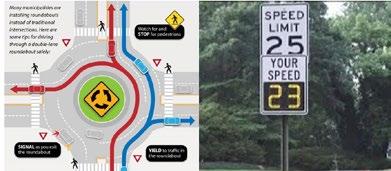
I heard a comment recently that I wanted to react to. There’s some feedback that it’s useful to have faster speed limits in town: it keeps the traffic flowing, it teaches reaction time and how to handle a vehicle. The basic argument against slower speeds goes something like, “The traffic is already awful, you liberalsnowflake-enviro-idiots want to make it worse.” I’m sorry, but that’s wrong. People who believe that we need to perpetuate the status quo of sending our kids to school alongside a highway are literally killing children. It’s that simple. The time you'd save traveling from the Y to Stateline if the speed limit was 30mph and not 40mph is only 1.5 minutes. A child’s life is worth 1.5 minutes of your precious time. Here’s the simple math:
The “Y” in South Lake Tahoe is about 3 miles from the Stateline casino area.
At 40 mph: Time = 3 miles at 40 mph = 0.075 hours ≈ 4.5 minutes
At 30 mph: Time = 3 miles at 30 mph = 0.1 hours ≈ 6 minutes
Difference: about 1.5 minutes longer
To find out more about how we can make our community safer, I reached out to former South Lake Tahoe City Councilmember and former Mayor Pro-Tem John Friedrich, who has represented South Tahoe with numerous agencies and has been instrumental in many local environmental stewardship initiatives.
Me: What would you point to here in town, in which you’ve been involved, that improved outcomes for cyclists and pedestrians?
John: Well, one of the things we did that I was proud of as my first action on council was bringing back a resolution to stop the Loop Road from going through the Rocky Point neighborhood. I thought it was a very Eisenhower-esque idea to build a highway through a diverse neighborhood to facilitate the fast movement of cars when our goal, at all levels, is to minimize private auto use. There was also the COVID-relief funding from the federal government. We got the community involved to vote on how we should spend that money and one of the allocations was for some bicycling infrastructure.
Me: Let’s talk about the asphalt desert of a 90-foot-wide highway that butchers its way from one end of town to the other. What kind of power do we have as citizens, and you as the town council, to do something about a state-owned highway?
John: Yeah, good question. If you go through Bridgeport at 50mph, you're definitely getting a ticket. The same with Lee Vining, right? You enter those communities and there’s a big flashing sign, you slow down. And Bishop is a long stretch, probably equivalent to our town. Drivers slow way down. There is a process, there was state legislation. There is a California Assembly bill, AB-43, that gives
communities jurisdiction or at least more input regarding the roads in their town. That didn't happen while I was on council. I wish it would have, but it still could happen. There was a huge amount of effort towards making the Stateline area into a “Main Street” and the Loop Road was going to facilitate that at some level. My thought was, “Why not make as much of Highway 50 on the South Shore as possible into a Main Street?”
John actually left me with some homework here to follow up with Heather Stroud, our city attorney, and Joe Irwin, our city manager, regarding the Strategic Plan for South Lake Tahoe to see if we have been able to use AB43 to take back some power from Caltrans. What I find out will be in my next column.
Me: If you're in a residential neighborhood where the speed limit is 25mph, your chances of being in a bad accident are much less, right?
John: Yes. Speed kills.
Me: And the lack of crosswalks is a problem.
John: Caltrans had a Highway 50 safety study and they are going to put in some additional crosswalks and lights and features along Highway 50. That's a start. But again, that's only a start. The statistics are very clear that the faster cars are going, the more accidents you have. That's the reason why roundabouts are so good. My opinion is that we should have roundabouts all the way
up and down Highway 50. Those are structurally safe. You slow down. You might get little dings, but you're not going to have catastrophic accidents in a roundabout.
Me: What about the snow snake: the “sculpture” that we build in our center turn lane almost every time it snows? It’s dangerous and wasteful. Isn’t there a better way?
John: Good question. What is the plan that NDOT uses to manage snow through Stateline when they reduce lanes for the Main Street line? How does King's Beach do it? How does Tahoe City do it? How do they do it in Colorado? Plenty of other places in the world figure out alternative ways to manage snow. We can too. If there's a will, there's a way.
Me: John, thanks for talking to me today and thanks for everything that you’ve done
for South Lake Tahoe over the years. Change is hard and there will always be naysayers and detractors; thanks for putting our community first. John: Thanks for the opportunity. I’ve enjoyed being able to contribute positively to our town. In the future, I’d love to see Highway 50 reimagined, maybe a dedicated bus lane, more pedestrian refuges, more dedicated bike lanes, and generally encouraging people to get out of their cars.
M.C. Behm is a full-time resident of South Lake Tahoe and author of “Once Upon a Quarantine” and “The Elixir of Yosemite.” Available locally and online. To learn more or respond to columns visit www.behmbooks. com or email mcbehmbooks@ gmail.com


I have this friend . great starting line, right? Who walks into a bar, or rather rides into a bar (even better). She rides this very cool, totally custom cruiser we built for her and looks great riding it. She sits down for a beer and of course engages with a patron there and soon they start talking bikes.
As things go along, he is giving her advice on what she should be riding, which she refutes, say-
ing she has someone who helps her with that stuff. At some point in the conversation, she mentions her “bicycle boyfriend,” which is what she calls me as I have been taking care of her family’s bikes for at least a decade or probably more like two.



So of course, he asks who this “bicycle boyfriend” is, and when she tells him, he says that he works in a local bike shop, too. Then he says, “Oh, that’s why your bicycle boyfriend is giving you that advice, he is so old school.” Well, I would say he is pretty right on about that. I have been working in bike shops longer than he has been alive. I’ve seen a lot, I know a little bit and am learning more all the time.
Old school is fun, especially if you can move in and out of that new and old reality. I do really enjoy the history of bicycles, especially mountain bikes. I enjoy classic cars, motorcycles, boats, and I have a deep affinity for the back story of skis and snowboards. That old school stuff can be really enjoyable, particularly when you can understand how and why it has influenced where we are today, and even more so if you have been able to experience some of that firsthand!
Now don’t get me wrong here. I’m not offended by bar dude’s comments, but I may be somewhere deep inside trying to
defend my sometimes slightly bitter slip into a frivolous bit of modernity. Some of this new school crap is pretty useless, new for the sake of new, then gone tomorrow. Some will stand the test of time and some will just be fun stuff to play with and learn from for a little while.
And I do love playing in a world somewhere in between old school and new technology. The two bikes I ride the most are perfect examples of this ideology.
The hardtail I ride is the new version of Don Koski’s late ‘70s
Pro Cruiser, which I bought back when he built 500 of them. The new version, also limited production, has 27.5-inch wheels. I run mid-fat tires, American-made titanium motocross style handlebars, very retro looking—Rockshox fork and a dropper seat post, brakes and hubs also American built; more on those later. The most fun part of this bike, though, is the drivetrain. I had my frame builder weld in a Pinion gear box, which was developed in the Porsche transmission factory in Germany…very tech. It sits in the bottom bracket area where the cranks attach. Eighteen gears, all internal and no rear derailleur.
You can shift pedaling, gliding, or even just sitting still, no matter.
Then I added a Gates carbon drive belt instead of a chain, silent and
clean. Very old school, retro high tech—or, well, just fun!
My full suspension is a full carbon frame with mixed wheels, 29-inch front 27.5-inch rear, five inches of travel front and rear, normal, modern technology. Then it gets weird. My brakes (on both bikes) have gone old school, cable actuated non-hydraulic disc brakes made by Paul Component Engineering, right here in California. Powerful, simple, retro. The rear derailleur is not electronic; no Bluetooth, no batteries to charge, I’m sticking to old school cable actuated one-by-twelve and it is one of the only rear derailleurs made in the U.S. by Vivo, really beautiful, very nice shifting…fun. Then, right next to that, you might start to see a theme here with the American made Onyx hub, silent gliding, instant engagement, awesome.
Quick change of channels. Did you get any of that monsoonal flow rainy goodness in August? Because that was not to be missed. Simply some of the best riding this summer. We got fully soaked on one ride, and it was so worth it! This old school, retro tech grouch can only hope for some more of that this autumn.
Let’s play!





This month we have two very different films, both a bit out of the mainstream. One became extremely popular, the other had a smaller, more select audience.
One of the most popular streaming films right now is a film many of you might not have heard of, (though with all its recent press, maybe you have), and it’s called K-Pop Demon Hunters, now on Netflix. The film was made by Sony Pictures Animation and in a bad decision in hindsight, they decided to sell it to Netflix for $125 million instead of giving it a theatrical release. Even Netflix didn’t give much energy to its streaming release, but after picking up steam, it has since become Netflix’s most watched film of all time and has the highest charting soundtrack of 2025, with a number one hit on the Billboard 200, marking the first time a fictional music group has topped the chart.
It also recently made another $18 million in a small, select, singalong theatrical release. If they had opted for a theatrical release, then Sony probably would have been looking at a $1 billion box office.
So, what is it? Well, it puts us in an anime world featuring fictional superstars, Rumi, Mira and Zoey who are a K-pop su-
pergroup called Huntr/x, but that is a cover for their real purpose, which is secretly being badass demon hunters who hunt down soul-stealing demons to protect their fans and the world from the king of the demon world. Their songs strengthen a magical barrier called the Honmoon, which helps keep the demons out. But the demons have a plan and Huntr/x will encounter their biggest enemy yet—an irresistible, rival boy band of demons in disguise. How will they overcome the demons to keep the world safe?
The first thing that makes the film really work is the animation, which is in the same vein as the popular Spider-Man Across the Spiderverse (also made by Sony Animation). It evokes an anime style with vibrant colors and energetic, stylized action, and since the film is a musical, much of the action is supported by song, which is mostly high energy K-pop. But you can add in some character depth and an emotional power that makes it heartfelt and sincere while also adding humor, which at times even pokes fun at the K-pop culture it is based on. It was director Maggie Kang's desire to create a story inspired by her Korean heritage, drawing on elements of mythol-
ogy, demonology, and K-pop culture. If you don’t know anything about K-pop culture, that’s okay because the film stands on its other merits. The plot isn’t that much different from any classic Disney film about young characters facing their fears and insecurities and discovering power in their truth while singing about it. Plus, the music is catchy and just might have you moving with the beat.
Second up is Wes Anderson’s latest film, The Phoenician Scheme, which was briefly in theatres but has just dropped to $9.99 on Prime. This is the latest full length Wes Anderson film following Asteroid City and is completely in the Wes Anderson style. It has the specific, soft color palettes as well as the extremely balanced and symmetrical settings with minute details, layered with a level historic nostalgia. As I have said before, his scenes often look more like artworks than settings. The film also has quirky characters with a low-key humor that pervades the entire film and characters delivering emotional moments in a deadpan style as they participate in a fantastical story.
In The Phoenician Scheme, wealthy arms dealer Zsa-zsa Korda, played by Benicio Del
Toro, survives another assassination attempt and appoints his only daughter Liesl, a soon-tobe nun, as sole heir to his estate, with hopes that she will take over the business. Since all of Korda’s money has come from ill-gotten means, Liesl only accepts being heir so she can distribute his wealth to the poor. Korda and Liesl have an antagonistic relationship since Korda sent Liesl away to a convent at the age of five and is rumored to have murdered Liesl's mother, although he denies it. Korda has one last scheme to make a huge payout but keeps running afoul of assassins who have crashed his plane more than once, yet he keeps surviving. As he gathers Leisl, we also meet Bjørn, played by Michael Cera, a Norwegian entomologist who is Korda's tutor for his other children and his administrative assistant. Soon, Korda, his daughter and Bjørn become the target of scheming tycoons, foreign terrorists and yet more determined assassins.
Like most Wes Anderson films The Phoenician Scheme is a comedy with the humor coming from the low-key, deadpan delivery of an offbeat script, creating absurd situations and how they are dealt with. There is a running


gag dealing with a box of hand grenades that I thought was hilarious. As opposed to some of his other recent films, The Phoenician Scheme has multiple locations around the world that are re-created in his specifically built sets, so there is a nice variety of settings framing the action. There is the usual cadre of characters played by well-known actors like Tom Hanks, Brian Cranston, Hope Davis, Jeffrey Wright, Scarlett Johansson, Benedict Cumberbatch, Bill Murray, Willem Defoe and F. Murray Abraham, among others.
Overall, The Phoenician Scheme is another grand entry in the Wes Anderson opus. If you are a Wes Anderson fan, you will love it. If you are not familiar with his films and you don’t know his film style, it is quirky and not high energy, but if you can accept the pace and offbeat humor, and then you might really enjoy it.
Teresa and I both love his films and we both loved this one. Unfortunately, she missed K-Pop Demon Hunters when I watched it, but she has it on her list to see.



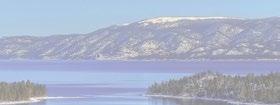
















gave a talk where she said the most common problems are weak stream, frequency, urgency, incontinence, nocturia, and retention.
Pelvic floor dysfunction is the most common issue she treats at her South Lake Tahoe office.

“Pelvic floor dysfunction can manifest itself in many different ways. It may cause frequency to pee, urgency to
pee, burning when you pee,” Locke said. “A lot of patients feel like they have urinary tract infections, but I’m unable to find bacteria to explain it. It can even cause testicular discomfort in men.”
Locke prefers trying conservative approaches first, like looking at a patient’s diet. Eliminating caffeine, alcohol, spicy and acidic foods, and artificial sweeteners could help. Next options include managing a patient’s stress, getting them to quit smoking, limiting fluids to two drinks before bedtime, doing pelvic floor exercises, taking a sitz bath, and then acupuncture.
Medication is her last resort.
“Insurance companies love them. I try to avoid them if I can,” Locke said. With age, the bladder loses elasticity, it can become oversensitive, the muscles can stop working, and blockages may develop.
Locke threw out statistics like:
• 23.3 percent of people in the U.S., with 30 percent being women and 16.4 percent men, as of 2016 had overactive bladders;
• Urinary leakage affects 1 in 4 women over the age of 18 and up to 10 percent of men;


• A weak stream in men is often from an enlarged prostate, with 94 million men worldwide diagnosed in 2019, up from 51 million in 2000. She explained how the bladder is a layer of three muscles with receptors that tell the brain you need to urinate. These aren’t muscles one often thinks about. Like most muscles, though, they can carry tension, which can lead to problems. Locke is a big believer in pelvic floor physical therapy, or having people do Kegel exercises at home to strengthen those muscles for better bladder health.
